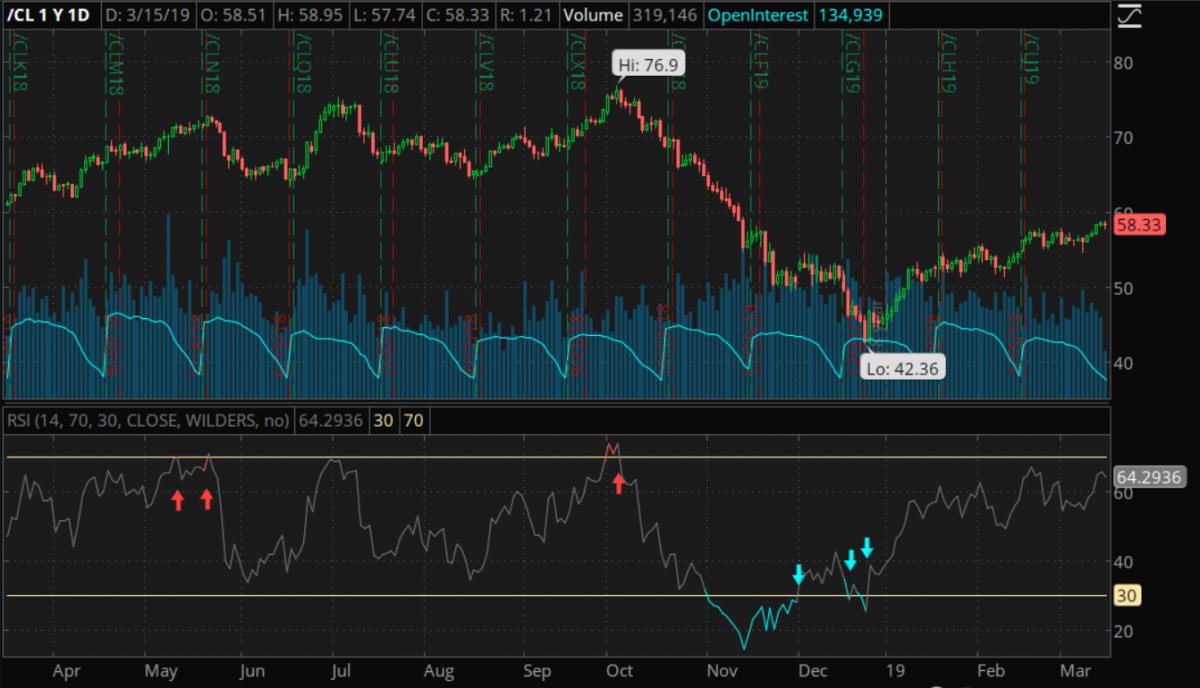The oldest debate in trading and investing is the relative merit of technical versus fundamental analysis. Most technical analyses are, at their heart, about identifying points at which support and resistance have appeared in the past and are likely to appear in the future. That is important information, but any predictions that result are rendered moot by a shift in fundamental conditions. When it comes to commodities such as oil, however, price itself can produce that fundamental shift, so a technical metric that measures momentum shifts can be especially useful in that and related markets.
Recently, even as demand expectations have varied, oil pricing has been dominated by the supply story. Agreed output cuts from OPEC and their partners pushed oil up from its lows but increasing U.S. output halted and reversed that move. The thing is, supply is inherently price-sensitive. Higher prices encourage and enable increased production then, when that comes online, price tends to fall until supply reduction results.
For short-term trading, the time periods can be as short as one minute, but RSI, with a few caveats, has proven very effective in predicting longer-term swing moves in oil over the last few years, using 1-day periods.
Those caveats are important.…
The oldest debate in trading and investing is the relative merit of technical versus fundamental analysis. Most technical analyses are, at their heart, about identifying points at which support and resistance have appeared in the past and are likely to appear in the future. That is important information, but any predictions that result are rendered moot by a shift in fundamental conditions. When it comes to commodities such as oil, however, price itself can produce that fundamental shift, so a technical metric that measures momentum shifts can be especially useful in that and related markets.
Recently, even as demand expectations have varied, oil pricing has been dominated by the supply story. Agreed output cuts from OPEC and their partners pushed oil up from its lows but increasing U.S. output halted and reversed that move. The thing is, supply is inherently price-sensitive. Higher prices encourage and enable increased production then, when that comes online, price tends to fall until supply reduction results.
That cyclicality is, to some extent, predictable and can be measured by certain metrics. When it comes to oil, the most reliable of those recently has been the Relative Strength Index (RSI).
RSI is, in chart analysis terms, relatively new. It was first introduced in 1978 by J. Welles Wilder and is a measure of the relative strength of moves up over moves down during a given time, usually 14 time periods. The last 14 readings are then averaged to smooth out the curve and plotted, usually below a regular chart. It is not necessary to know the exact formula to use RSI (math nerds can find it here though). It is enough to know that a reading of under 30 is taken to indicate that a traded instrument is oversold and over 70, overbought.
For short-term trading, the time periods can be as short as one minute, but RSI, with a few caveats, has proven very effective in predicting longer-term swing moves in oil over the last few years, using 1-day periods.
Those caveats are important. As with any momentum indicator, RSI can often give false signals. Momentum is powerful, and a move often continues beyond its logical endpoint. In addition, pauses and small retracements can falsely suggest a reversal during a sustained move. Those two problems can be overcome by using re-entry into the “normal” range as the signal rather than exiting it and waiting for two such re-crosses before acting.
False signals are still possible, however, so stop losses should be used at all times. One of the advantages of using RSI is that the re-cross of the indicator line comes as a reversal occurs, which creates a recent, fairly close level that can be used as a basis for stops. Limiting potential losses like that makes it reasonable to try again on a third signal should the second also prove to be false. Once in profit, moving to a trailing stop allows you to maximize the potential profit. It should also be said that when using that approach, a bounce back to the opposite signal line negates what came before and results in a re-set.
So, let’s look at how that works in practice…

(Click to enlarge)
The chart above is for WTI futures (CL). RSI is plotted beneath the main chart, with the crossovers marked by the arrows. As you can see, back in May, the second crossover marked a momentum reversal that, depending on your stop levels, could have resulted in a small profit. The third red crossover, though, came in Early October, right before WTI crashed. With the blue arrows, the second cross would have been a false signal and resulted in a small loss, but again the third marked a real turning point.
Swing trading using RSI demands patience and discipline, but that is true of trading generally and, as you can see from the examples above, it can be useful for indicating real momentum shifts. How you use that information is of course up to you. It can be used for futures, although the timing of the trades will often necessitate rollovers, which can be expensive. Or, it could be used to trade stocks that are sensitive to oil prices, such as XOM or BP, for example. Tracking ETFs such as USO can also be used, although there again the effects of time can distort returns.
Whatever you use to trade its signals though, adding RSI to your energy investing toolbox is a smart move.
By Global Energy Alert
Investor Alert
This is an excerpt from Oilprice.com's newest intelligence service 'Global Energy Alert' which is set to be launched next month.
For readers interested in guaranteeing themselves an opportunity to access this service, please email support@oilprice.com stating your interest and we will reserve you one of the 500 available spaces.
Members of the Oil & Gas Insider will automatically gain access to this new service.
















